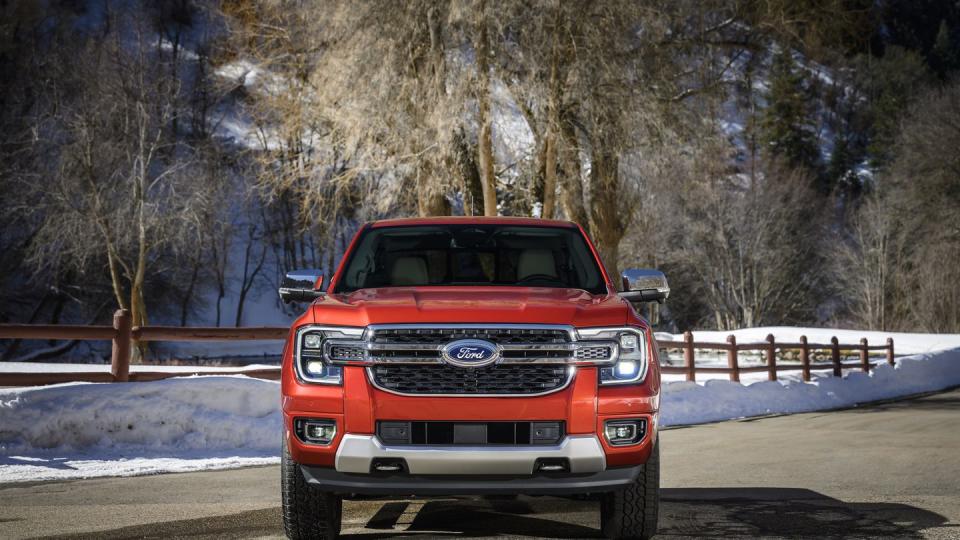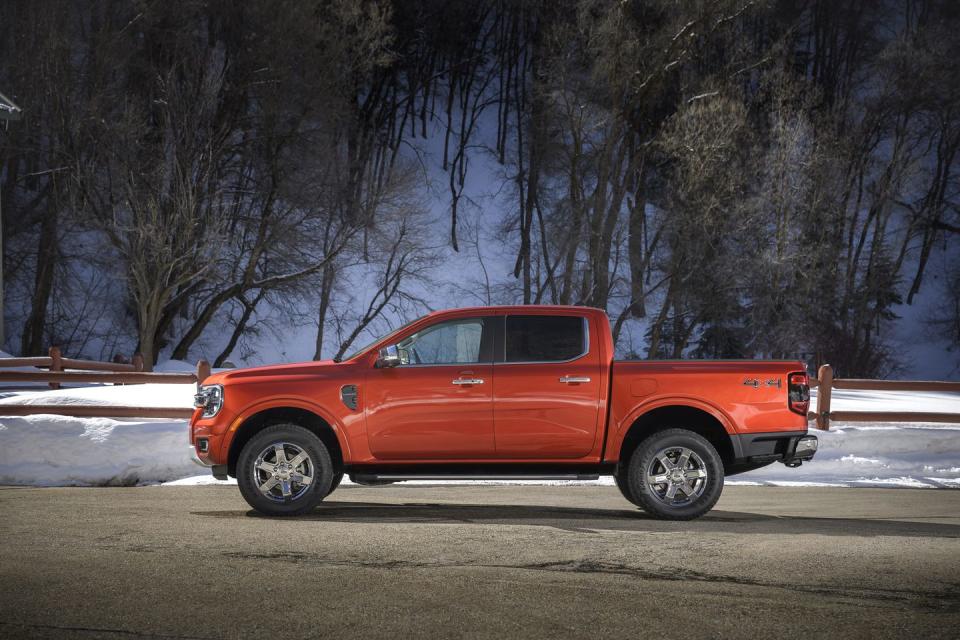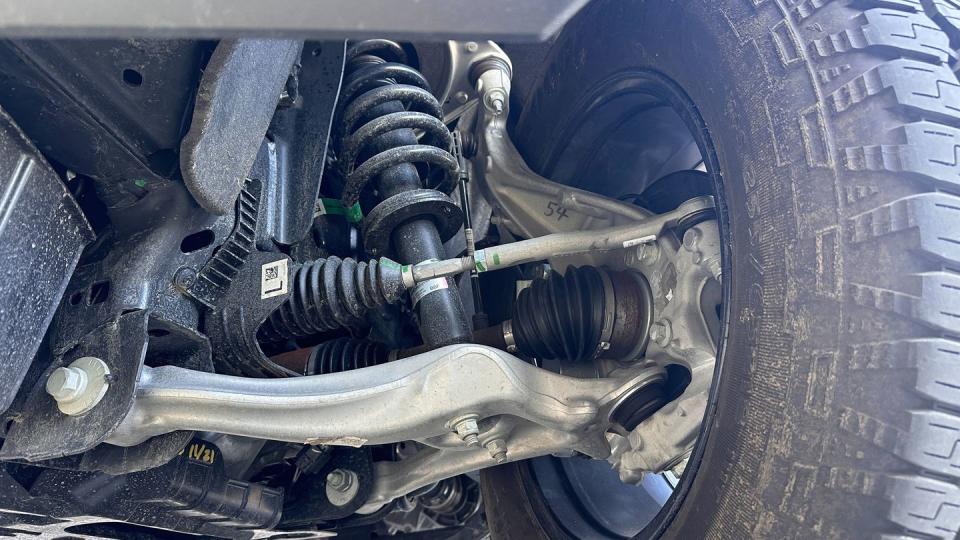2024 Ford Ranger First Drive: Finally Built to Play Ball

The outgoing Ford Ranger, which debuted in the U.S. as a 2019 model, was a federalized version of an eight-year-old world-market Ranger that the local Ford team put together to reenter the game. The 2024 Ford Ranger represents a full-court press meant to transform this newest Ranger into a legitimate threat.
It's tough being a mid-size pickup nowadays, not least because a recent surge in new product has made an already-competitive field that much more cutthroat. Ford's Ranger, in particular, had a lot of ground to make up, finishing fourth of four in a comparison that took place even before the competition made recent strides. Could it dig itself out of an ever-deepening hole? The task is not as imposing as it seems.
My, How You've Grown
At first glance, the Ranger now looks more like a downsized F-150, as it shares the broad-shouldered look of the bestseller. It's no illusion, because the new Ranger is 2.2 inches wider than the old one, and its front and rear track widths are each meatier by 2.4 inches. Its 128.7-inch wheelbase is likewise 1.9 inches longer than before, but it's a fractionally shorter from nose to tail thanks to some front and rear overhang trimming. Its flanks have also traded the previous model's exaggerated rake for a more traditional stance. The largest tires now stand 31 inches tall, which is an inch taller than before, and the smallest wheel diameter is now 17 inches. The end result is a Ranger that looks burlier and beefier but still maintains the tidy dimensions necessary to negotiate tight parking lots and ease into a garage as a mid-size should.

Engines Old and New
Under the hood, the new Ranger retains the EcoBoost turbocharged 2.3-liter four-cylinder from before, and it makes the same 270 horsepower and 310 pound-feet of torque. It somehow feels punchier here, although that was never a problem before. The 10-speed automatic's first- and second-gear ratios are indeed shorter, but the numerical difference doesn't seem significant enough to explain the apparent increase in verve. Maybe our memory has gone soft. It'll take a track test to see if the new one is quicker than the 6.5 seconds to 60 mph we measured with the retiring player.
The EPA says that the four-wheel-drive models' fuel economy is unchanged at 22 mpg combined (20 city/24 highway), but two-wheel-drive thrift has sagged from 23 mpg combined to 22, owing to a highway rating that has backtracked from 26 mpg to 25 mpg. We're not too bothered by this small slip; in fact, we're kind of impressed because, while the new truck isn't meaningfully heavier, it does punch a significantly larger hole through the air. Perhaps the taller tires amount to a higher effective final drive, which is otherwise identical from an axle-gearing standpoint.
The new Ranger's extra width comes with wider-spaced frame rails that make room for V-6 engines. The F-150's EcoBoost twin-turbo 2.7-liter V-6 will be optional, and here it'll make 315 horsepower and 400 pound-feet. We haven't had the opportunity to drive it yet, and it won't arrive until midyear, but EPA filings suggest V-6 Rangers will be limited to 4WD and will be rated at 20 mpg combined (19 city/23 highway). And then there's the Ranger Raptor, which is new for North America and will sport a twin-turbo 3.0-liter V-6 that'll make 405 ponies and 430 pound-feet. Look for details on the junior Raptor in a separate review.

A Vastly Improved Ride
At first glance, the new Ranger's suspension doesn't seem all that different. The front still rides on dual control arms, while the rear wields a live axle with dual leaf springs (one steel primary and a helper). A second glance, however, reveals that the upper and lower control arms are now aluminum instead of steel, the helper rear leaf spring is now made of composite, and the shocks have moved outboard of the leaf springs. All are good changes, and they pair nicely with reformulated spring and damper tuning that exorcises the old truck's pronounced float and wallow. Add the taller tires' extra sidewall and you end up with a smooth-riding Ranger that also feels infinitely more stable and buttoned-down. The changes don't eliminate all the prior dribble, particularly on an FX4-packaged Lariat model with 18-inch rolling stock, but it's a giant leap forward nevertheless.
One area in need of further coaching is the steering, which exhibits the typical Ford-truck syrupy vagueness that masks the on-center definition necessary to guide the truck subconsciously. There's buildup when you bend it into corners, but it's more of a suggestion of cornering feel instead of the genuine article.

Major Cabin Changes
The cabin is clearly the most improved player on the Ranger bench—of course, the front seats themselves are attractive-looking buckets. The surroundings are interesting and layered, and the materials are varied, mostly soft-touch, and attractive. The interior environs still give off a Ford-truck vibe, but this is a worst-to-first moment in terms of mid-size-truck interior design, materials, and execution. There's decent storage, too, in the form of a wide console, a rubberized dashboard shelf, and an available second glovebox. The back seat is decently spacious (for a mid-size rig), and the rear seatback now folds fully flat to make a horizontal load surface, but Ford fumbled by not offering a 60/40 split so one person could ride with the other part folded.
Most of the controls are straightforward, but the shifter defies convention. The release button is on the front, but your thumb falls naturally to the side, where the manual shift buttons live. This is fine shifting into Drive, because your index finger is nearby, but it's weird going back to Park because an open-palm push feels natural. Your hand also covers the PRND indicator, so you can easily overshoot Reverse. We might get used to it, but that doesn't mean it'll ever feel natural. Beyond that, the highly preferable 12.4-inch central touchscreen stands tall in portrait mode, confining smartphone mirroring (wired and wireless) into the upper two-thirds. This leaves the bottom third open for always-there shortcuts to other screens and the climate control, but this is odd because physical HVAC knobs and buttons reside just below. Something for everyone, we guess, and still much improved from before.

One Body, Three Trims
The Ranger's extended cab and six-foot bed are history, which means the sole remaining body combination comprises a five-passenger crew cab and a five-foot bed. That said, "five-foot" now means 59.6 inches at the floor instead of 61.0, but we think this is more than offset by the wider suspension accommodating an expanded wheelhouse width (48.2 inches, up from 44.8). In more practical terms, that means the Ranger's bed can now hold plywood and drywall panels flat on the deck, an impossible feat among its competitors, save for the Honda Ridgeline. The open bed's floor is seven feet long to the end of the tailgate, which is now damped, has a torsion spring to ease closing, and is tied into the central-locking function. Another feature we really like is the boot-friendly Integrated Box Side Step built into both fenders ahead of the rear bumper, a no-brainer option at $215. Maximum payload for 2WD models is 1805 pounds, and 4WDs can tote up to 1711 pounds; the max tow rating is 7500 pounds in either case.
As before, the Ranger comes in XL, XLT, and Lariat trims, with prices now opening at $34,265. The Tremor is not (yet?) offered because of the new Raptor, but you can get the modest FX4 off-road setup with its electronically locking rear differential, skid plates, suspension tuning tweaks, running boards, and FX4 graphics for $1295. The two-wheel drive FX2 version has been benched, however. If you want an electronic locker without said FX4, you can get that by itself for $420. Selecting the Chrome package nets you extra brightwork and 18-inch "chrome-like" wheels for no cost—well, except for the compulsory addition of the $215 box step.
Is the new Ranger a slam dunk? It has vastly improved stats, but it will take more game time and an instrumented test to know how it stacks up against the competition. It's clearly no longer alone in the basement, and despite a few quibbles, there's a lot we really like. For some people, that could add up to a win. It's certainly in the running for most-improved player.
You Might Also Like

 Yahoo Autos
Yahoo Autos 